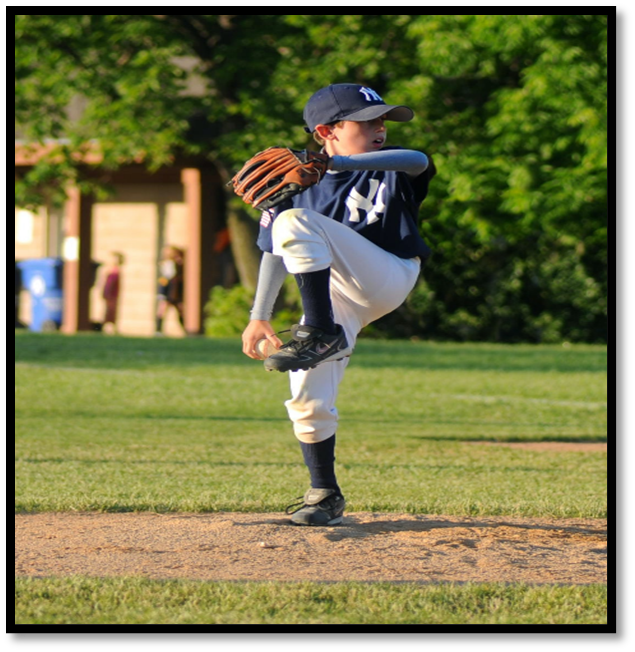02/22/2022
Youth Baseball Shoulder and Elbow Injuries
By Dr. Gavin Webb, Wentworth Health Partners Seacoast Orthopedics & Sports Medicine
Due to the nature of baseball, youth players are at risk of overuse injuries of the shoulder and elbow from throwing. Repetitive overhead throwing can lead to stress on muscles, tendons, ligaments, cartilage, and even bones in the shoulder and elbow. Symptoms of an injury include pain while throwing, discomfort even at rest, stiffness, swelling, and loss of velocity or accuracy. Below are the most common shoulder and elbow injuries seen in baseball players and what to do if you suspect an injury.

Common Shoulder Injuries
Little League Shoulder - overuse injury caused by stress to the arm bone (humerus) nearest to the shoulder. This stress causes widening of the growth plate, resulting in swelling and pain at the shoulder. It most commonly occurs in youth overhand pitchers between ages 11 and 16. If untreated, the condition can worsen, leading to bone damage and possible growth plate closure.
Rotator cuff strain – overuse or partial tearing of the tendons that attach the rotator cuff muscles to the bone.
Internal Impingement – this can occur in pitchers when the range of motion in the throwing shoulder changes and the rotator cuff and labrum are damaged from repetitive stress.
SLAP or labral tears - tearing or separation of the labrum from the cup or socket of the shoulder can result in painful clicking or catching in the shoulder.
Common Elbow Injuries
Little League Elbow - overuse injury caused by stress to the inside of the elbow. The disorder occurs in youth with open growth plates. If untreated, the condition can worsen, leading to bone and/or ligament damage and possible growth plate closure.
Medial epicondyle injuries – the growth center on the inner side of the elbow can be damaged from repetitive injury or from a single acute injury that causes a type of fracture.
Ulnar collateral injuries- the ligament on the inner side of the elbow can be damaged from repetitive stretching from throwing. Partial tears usually respond to conservative treatment whereas complete tears often times need surgery.
Ulnar neuritis – irritation of the nerve on the inner side of the elbow can cause pain and changes in sensation in the forearm and hand. Left untreated, it could cause weakness in the wrist and hand.
The following factors contribute to all of the above injuries:
• Repeated overhead throwing without proper rest
• Pitching and throwing with improper mechanics
• Lack of muscle strength, specifically in the shoulder, upper back, core and legs
How is the diagnosis made?
A doctor will complete a detailed history and physical exam and may order imaging tests. Often times an x-ray can be helpful in ruling certain injuries in or out. In some cases, an MRI may be necessary.
Types of diagnostic tests:
• X-ray: the most common test for a shoulder and elbow injuries. This test can show a widened or irregular growth plate or an abnormal area of bone in the joint.
• Magnetic resonance imaging (MRI): provides a more detailed image of both soft tissues and bone. It can look at tendons and ligaments, which cannot be seen with X-rays alone. It also provides more detail of the growth plates.
Once the diagnosis is made, many of the injuries are treated in the same way:
Conservative management:
• Rest – your doctor may suggest you avoid throwing activities for a period of time.
• Ice and anti-inflammatory medication (nsaids) - this helps to decrease swelling and pain in the joint.
• Physical therapy – strengthening and stretching regimen that will focus on strengthening of the shoulder and arm muscles. Strength of the core, legs and hip are emphasized to enhance stability and overall ability to throw.
• Video throwing analysis – By performing video analysis of throwing motion, trained providers are able to break down the phases of throwing to look for deficiencies.
• Return-to-throwing program – once cleared to return to throwing, the athlete will undergo a progressive throwing program that slowly increases the forces and demands through the arm and shoulder, which are necessary for full return to competitive play.
While no injury can be completely prevented, proper mechanics, rest and strength can reduce the risk of injury. USA Baseball in partnership with major league baseball (MLB) has developed guidelines for young pitchers to help reduce the risk of injury. Research has shown that when youth baseball pitchers throw with fatigue, they are 36 times more likely to injure their shoulder or elbow.
 Gavin Webb, MD has been a team physician for the University of New Hampshire Wildcats since moving to the Seacoast in 2005. He is board-certified in both Orthopedic Surgery and Sports Medicine. An athlete himself, he provides care for patients throughout the entire age range and competitive levels from recreational to professional athlete. He specializes in arthroscopic and minimally invasive treatment of shoulder and knee conditions and has a special interest in treatment of cartilage injuries in the knee. He was a former baseball player and coached youth baseball for many years.
Gavin Webb, MD has been a team physician for the University of New Hampshire Wildcats since moving to the Seacoast in 2005. He is board-certified in both Orthopedic Surgery and Sports Medicine. An athlete himself, he provides care for patients throughout the entire age range and competitive levels from recreational to professional athlete. He specializes in arthroscopic and minimally invasive treatment of shoulder and knee conditions and has a special interest in treatment of cartilage injuries in the knee. He was a former baseball player and coached youth baseball for many years.
Your opinion matters! We value your input and hope you’ll take a moment to review our newsletter and share your thoughts on future content. Please consider filling out this brief survey.